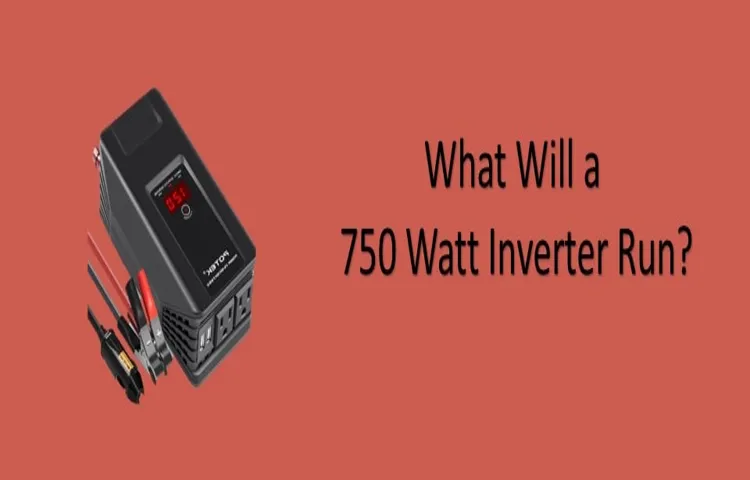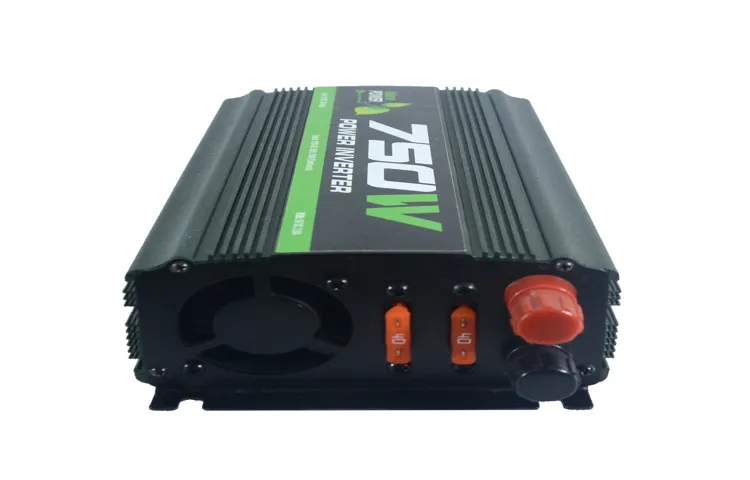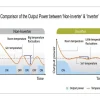Have you ever wondered how much power a 750 watt inverter uses? Well, you’ve come to the right place! In this blog post, we’ll explore the power consumption of a 750 watt inverter and provide you with all the information you need to know. An inverter is a device that converts DC (direct current) power, typically from a battery, into AC (alternating current) power, which is used by most household appliances and electronic devices. Inverters are commonly used in RVs, boats, and for emergency backup power.
The power consumption of a 750 watt inverter depends on several factors, including the efficiency of the inverter, the load being powered, and the duration of use. The efficiency of an inverter is typically expressed as a percentage, indicating how well it can convert DC power to AC power. For example, if an inverter has an efficiency rating of 90%, it means that it can convert 90% of the DC power it receives into AC power, while the remaining 10% is lost as heat.
This means that a 750 watt inverter with a 90% efficiency rating would consume approximately 833 watts of DC power. Additionally, the amount of power used by a 750 watt inverter will vary depending on the load being powered. If you are using the inverter to power a small device that requires only 100 watts of AC power, then the inverter will consume only that amount of power from the battery.
However, if you are using the inverter to power a larger device that requires 500 watts of AC power, then the inverter will consume 500 watts from the battery. It’s important to note that the power consumption of a 750 watt inverter will increase if the load being powered fluctuates or if multiple devices are connected to the inverter at the same time. This is because the inverter needs to deliver more power to meet the demands of the devices.
In conclusion, the power consumption of a 750 watt inverter can vary depending on factors such as efficiency, load, and duration of use. It’s important to consider these factors when determining the power requirements for your specific needs.
Table of Contents
Understanding Inverters
If you’re wondering how much power a 750 watt inverter uses, the answer is actually pretty straightforward. As the name suggests, a 750 watt inverter has a power output of 750 watts. However, it’s important to note that this is the maximum power it can provide.
The actual power consumption will depend on the devices you connect to it. For example, if you connect a device that requires 500 watts of power, the inverter will draw 500 watts from its DC power source. In this case, the inverter itself will consume a small amount of power, usually in the range of 10-15 watts.
So, even though the inverter is rated at 750 watts, it doesn’t mean it will use that much power all the time. It will consume only as much power as the devices connected to it require.
Overview of Inverters
inverters

Types of Inverters
inverter, types of inverters
Calculating Power Consumption of a 750 Watt Inverter
Have you ever wondered how much power a 750 watt inverter consumes? Well, let me break it down for you. A 750 watt inverter is capable of providing up to 750 watts of power to your electronic devices. However, it’s important to note that this doesn’t necessarily mean it will constantly draw 750 watts from your power source.
The actual power consumption of your inverter will depend on the load you connect to it. For example, if you are using an appliance that requires 500 watts of power, then the inverter will draw 500 watts from your power source. This means that the power consumption of a 750 watt inverter can vary depending on the devices you connect to it.
It’s always a good idea to check the power requirements of your devices before connecting them to the inverter to ensure that you don’t overload it.
Understanding Watts
Calculating Power Consumption of a 750 Watt Inverter If you’re considering purchasing a 750-watt inverter, it’s important to understand its power consumption. In simple terms, power consumption refers to the amount of energy used by an electronic device. In the case of an inverter, it converts DC (direct current) power from a battery into AC (alternating current) power that can be used to run household appliances or charge electronic devices.
To calculate the power consumption of a 750-watt inverter, you need to consider two factors: efficiency and duration of use. The efficiency of an inverter refers to how well it converts DC power into AC power. Inverters typically have an efficiency rating of around 85% to 95%.
Let’s assume we have an inverter with an efficiency rating of 90%. Now let’s say you want to use the inverter to power a laptop that consumes 50 watts of power. To calculate the power consumption, you divide the laptop’s power consumption by the inverter’s efficiency.
In this case, 50 watts divided by 0.90 (90%) gives you approximately 556 watts.
So if you were to use the laptop for 5 hours, the inverter would consume approximately 2778 watt-hours (556 watts x 5 hours).
This indicates the total amount of energy consumed during that time. Calculating power consumption is essential to ensure you don’t overload your inverter or drain your battery too quickly. By understanding how to calculate power consumption, you can make informed decisions about which appliances or devices you can safely run using your 750-watt inverter.
Wattage Calculation for Devices
power consumption, 750 watt inverter, calculating wattage
Power Consumption of a 750 Watt Inverter
power consumption, 750 watt inverter Have you ever wondered how much power a 750 watt inverter consumes? Well, let’s take a closer look and calculate its power consumption. First of all, it’s essential to understand what a watt is. In simple terms, a watt is a unit of power that indicates the rate at which energy is used or produced.
In this case, a 750 watt inverter is capable of converting DC power from a battery into AC power, which is what most of our household appliances use. Now, let’s delve into calculating the power consumption of a 750 watt inverter. The power consumption of an inverter depends on several factors, including the efficiency of the inverter itself and the load that is connected to it.
Efficiency plays a significant role in determining how much power the inverter uses to produce the desired output. Generally, the higher the efficiency, the lower the power consumption. For example, let’s say our 750 watt inverter has an efficiency rating of 90%.
This means that it can convert 90% of the DC power from the battery into AC power. So, in this case, the inverter would consume around 833 watts (750/0.9) to produce the 750 watts of AC power.
It’s important to note that the power consumption of a 750 watt inverter can vary depending on the load connected to it. If you connect multiple appliances that require a total power of more than 750 watts, the inverter will have to work harder and consume more power. On the other hand, if the load connected to the inverter is less than 750 watts, the inverter will consume less power.
In conclusion, the power consumption of a 750 watt inverter can vary depending on its efficiency rating and the load connected to it. However, by understanding these factors and making informed decisions about your power usage, you can optimize the efficiency of your inverter and minimize power consumption. So, the next time you’re using a 750 watt inverter, keep these considerations in mind and make the most of your power usage.
Factors Affecting Power Consumption
If you’re wondering how much power a 750-watt inverter uses, there are several factors to consider. The power consumption of an inverter depends on the devices connected to it and how much power they require. For example, if you connect a 100-watt device to the inverter, it will use 100 watts of power.
However, if you connect multiple devices that require a total of 500 watts, the inverter will use 500 watts. Additionally, the efficiency of the inverter can also affect its power consumption. Inverters are not 100% efficient, meaning that some power will be lost as heat during the conversion process.
The efficiency rating of an inverter will give you an idea of how much power it will consume. So, while a 750-watt inverter has the capacity to handle devices that require up to 750 watts, the actual power consumption will depend on the devices connected and the efficiency of the inverter.
Efficiency of the Inverter
power consumption, inverter efficiency, factors affecting power consumption.
Load on the Inverter
load on the inverter, power consumption, factors affecting power consumption The load on the inverter is determined by the power consumption of the devices connected to it. There are several factors that can affect the power consumption of these devices. Firstly, the type of device itself plays a role in power consumption.
For example, appliances such as refrigerators and air conditioners tend to consume more power compared to smaller devices like lamps or fans. Additionally, the efficiency of the device also matters. Older appliances may be less efficient and therefore consume more power.
Another factor is the duration of usage. If a device is used for longer periods of time, it will naturally consume more power. Furthermore, the number of devices connected to the inverter also affects power consumption.
The more devices there are, the higher the load on the inverter. It is important to consider these factors in order to properly assess the load on the inverter and ensure its efficient functioning.
Battery Capacity
battery capacity, power consumption, factors affecting power consumption Battery capacity refers to the amount of electrical energy that a battery can store. It is an important factor to consider when choosing a battery for any device, as it determines how long the device can run before needing to be recharged. There are several factors that can affect the power consumption of a device and, therefore, the battery capacity required.
One of the main factors is the type of device being used. Different devices have different power requirements, and therefore, different battery capacities. For example, a smartphone with a large display and powerful processor will require a higher battery capacity than a basic feature phone.
The usage pattern of the device also plays a role in determining the power consumption. If a device is used for heavy tasks or for a long duration, it will consume more power and require a higher battery capacity. On the other hand, if a device is used sparingly or for light tasks, it will consume less power and require a lower battery capacity.
Other factors that can affect power consumption include the screen brightness, the number of background apps running, and the connectivity options such as Wi-Fi and Bluetooth. By considering these factors and choosing a battery with the appropriate capacity, users can ensure that their devices have enough power to meet their needs.
Examples of Power Consumption
If you’re wondering about the power consumption of a 750-watt inverter, it’s important to understand what an inverter does first. An inverter is a device that converts direct current (DC) power, such as that from a battery, into alternating current (AC) power that can be used to power household appliances and electronics. The power consumption of a 750-watt inverter will vary depending on the load or the amount of power being drawn from it.
When the inverter is not supplying any power, it will consume very little, if any, power itself. However, as you start to connect devices to the inverter, the power consumption will increase. For example, if you have a 750-watt inverter and you connect a device that requires 500 watts of power, the inverter will consume close to 500 watts of power itself.
It’s always a good idea to check the specifications or documentation provided by the manufacturer for the specific model of inverter you’re using to get an accurate estimate of its power consumption.
Example 1: Running a Laptop
power consumption, laptop In today’s modern world, laptops have become an essential tool for both work and leisure. Whether you use it for browsing the internet, watching movies, or running complex software, a laptop relies on power to function. Have you ever wondered how much power your laptop consumes? Let’s consider an example to understand power consumption better.
When you use a laptop, it requires electricity to power its various components, such as the processor, memory, and display. Depending on the laptop’s specifications, the power consumption can vary. For example, a basic laptop with an Intel i3 processor and low-resolution display might consume around 30 watts of power under normal usage.
However, power consumption can increase significantly when you perform demanding tasks on your laptop. For instance, if you are running resource-intensive software like video editing or gaming, the power consumption can go up to 60 watts or higher. This is because the processor and other components are working harder, drawing more power from the battery or the electrical outlet.
It’s important to consider power consumption when using a laptop, especially if you are on the go or using it without access to a power source. Laptops with higher power consumption will drain the battery faster, meaning you’ll have to recharge more frequently. Additionally, laptops with high power consumption will generate more heat, which can affect performance and potentially lead to overheating.
To manage power consumption effectively, you can take a few steps. First, consider adjusting the display brightness to a lower setting, as the display is one of the components that consume a significant amount of power. Additionally, closing unnecessary applications and background processes can help reduce power consumption.
In conclusion, understanding power consumption is crucial when using a laptop. By being aware of how much power your laptop consumes, you can make informed decisions about usage and manage your battery life more effectively. So, the next time you use your laptop, take a moment to consider the power it requires and find ways to optimize its usage for a longer-lasting battery and better overall performance.
Example 2: Charging a Smartphone
One example that demonstrates power consumption is charging a smartphone. We all rely on our smartphones for various tasks throughout the day, but have you ever wondered how much power it takes to charge these devices? Well, when you plug your phone into the charger, it draws electrical current from the power source to replenish its battery. This current flows through the charging cable and into the phone, where it is converted into the energy needed to charge the battery.
The amount of power consumed during this process depends on several factors, such as the charging rate, battery capacity, and efficiency of the charger. For instance, if you’re using a fast charger, it will draw more power from the outlet to charge your phone at a higher rate. On the other hand, a slower charger will draw less power but take longer to fully charge your phone.
So, the next time you plug in your smartphone, think about the energy required to keep it powered up and ready to go!
Example 3: Operating a Small Refrigerator
examples of power consumption
Conclusion
In the quest for ultimate power, the 750 watt inverter emerges as a worthy contender. This mighty device devours electrical energy with an insatiable hunger, transforming it into a force that can electrify even the darkest corners of our lives. But how much power does it truly consume? Like an efficient superhero, the 750 watt inverter possesses a remarkable ability to convert energy.
When connected to a power source, it flexes its metaphorical muscles and draws upon a portion of the available electricity. This energy is then magnificently transformed into usable power, allowing us to charge our devices, run small appliances, and even bring light into the most remote corners of our world. However, like any superstar, this inverter does not work for free.
It demands a modest fee for its services, expressing its power-hungry nature by consuming a certain amount of electricity. In the case of the 750 watt inverter, it is capable of enjoying a hearty meal of approximately 750 watts per hour, a sum that would make any electrical meter tremble in fear. But fear not, fellow power enthusiasts, for this consumption is not without purpose.
The 750 watt inverter embodies the perfect balance between power and efficiency, striving to provide us with the maximum bang for our energy buck. Its design ensures that the ultimate power it demands is matched by the ultimate power it provides, resulting in a harmonious symphony of electrical wonder. So, whether it’s saving the day during a power outage or simply bringing electricity to the great outdoors, the 750 watt inverter is a humble yet formidable appliance.
It requires a sacrifice of electricity to work its magic, but in return, it sets the stage for an electrifying performance that leaves us in awe of its power.
FAQs
What is a watt inverter and how does it work?
A watt inverter is a device that converts DC power from a battery into AC power that can be used to run household appliances. It works by using electronic circuits to switch the direction of the current, thereby producing the desired AC output.
How much power does a 750 watt inverter use?
A 750 watt inverter can use up to 750 watts of power from a DC source, such as a battery. However, it’s important to note that the actual power consumption can vary depending on the load being connected to the inverter.
Can a 750 watt inverter power a refrigerator?
It depends on the power requirements of the refrigerator. A 750 watt inverter can typically handle the power needs of a small to medium-sized refrigerator, but larger refrigerators may require a higher wattage inverter.
What other appliances can a 750 watt inverter power?
A 750 watt inverter can power a variety of small to medium-sized appliances, such as laptops, televisions, fans, lights, and chargers for electronic devices.
How long can a 750 watt inverter operate on a fully charged battery?
The operating time of a 750 watt inverter on a fully charged battery can vary depending on the battery capacity and the power consumption of the connected load. It’s recommended to consult the manufacturer’s specifications or perform a test to determine the actual operating time.
Can a 750 watt inverter be used in a car?
Yes, a 750 watt inverter can be used in a car as long as the car’s electrical system can handle the power requirements. It’s important to ensure that the car’s battery and alternator are capable of providing enough power to the inverter.
How does the efficiency of a 750 watt inverter affect its power consumption?
The efficiency of a 750 watt inverter determines how much power is lost in the conversion process. A more efficient inverter will waste less power, resulting in lower power consumption from the battery or DC source. It’s recommended to choose an inverter with high efficiency for optimal power usage.



